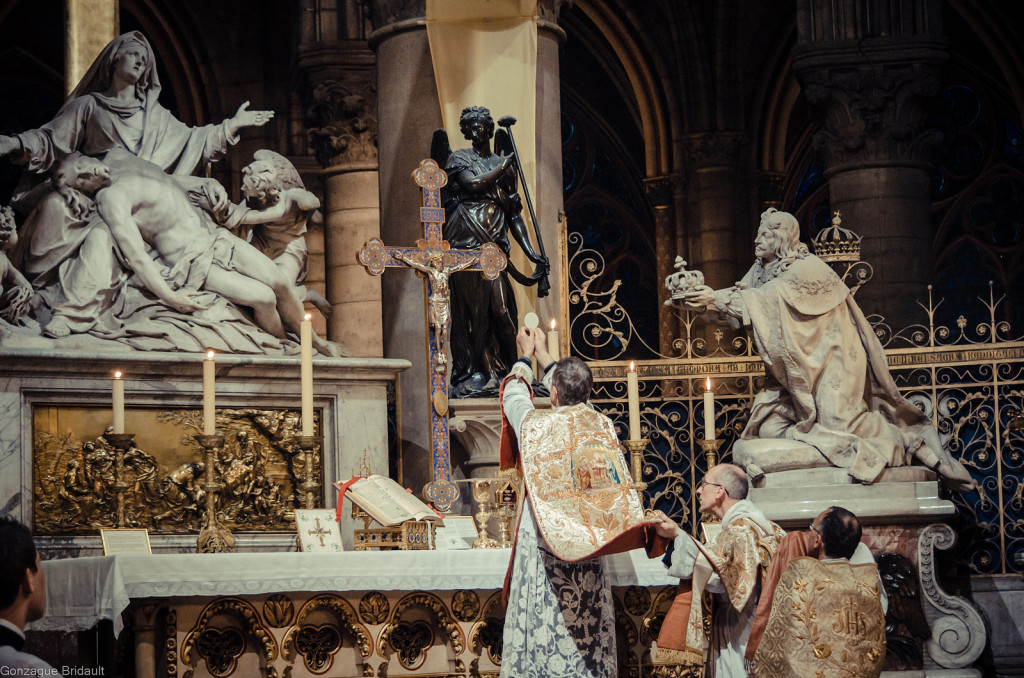By: Louis J. Tofari
 I have been attending the traditional Mass for about 7 years now. The element of the Mass that is so satisfying to me was found in its reverence. Every Mass I attended, regardless of the celebrant, was done in the same manner and precision. One aspect that was always very prominent was the Elevation during the Canon. The uniformity of the Mass was so beautiful and bought out the most in those who participate.
I have been attending the traditional Mass for about 7 years now. The element of the Mass that is so satisfying to me was found in its reverence. Every Mass I attended, regardless of the celebrant, was done in the same manner and precision. One aspect that was always very prominent was the Elevation during the Canon. The uniformity of the Mass was so beautiful and bought out the most in those who participate.
For all these years, it was very obvious, that the formation of the priests, who say the Tridentine Mass, was very structured and complete. It was as if all the celebrants where cut from the same cloth. Recently, we had a change [of] celebrant and right away, his way of saying Mass was different. Everything was rushed and it was most evident in the Elevation. You cannot get out one, “My Lord and My God”, let alone three, before the Eucharist is lowered.
I have heard that a quickening can occur as we near the Canon, in anticipation to the Real Presence of Christ in the Eucharist, but this is ridiculous. For us who like to participate in the Mass by reading along the liturgical prayers, we must read at a pace that gives no time for reflection. This same realization has been mentioned by many others as well.
Please advise on what is going on and what is proper?
***********************************************************************
I am thankful for your question which gives me the opportunity to address several issues at once.
Firstly, concerning the priest — or celebrant — it is important that he adhere to the rubrics as closely as possible, so as to avoid any personal affectation and to secure uniformity in how the rite of Mass is offered. Indeed the priest is supposed to suppress his personality as much as possible so that he may always appear as alter Christus.
As the great rubrician J.B. O’Connell remarks in his work, The Celebration of Mass: A Study of the Roman Missal, conformity of the celebrant’s actions with the rubrics (his deportment, how he holds his hands, bows, etc.) is a special form of spiritual discipline for the priest.
In addition to the rubrics printed in the missal, there are many manuals available to priests that provide further instructions not explicated in the liturgical books, but generally agreed upon in common by rubricists (those who are recognized as experts on such matters). In this regard, there are two points in your question that I would like to briefly clarify, first the pace of the offering of Mass, and thus, second, the timing of the Elevation moment.
Regarding the first point, all rubricians are in agreement that the pace of the celebrant in reading the prayers and in making the various actions should be done at a moderate pace, neither too fast, nor too slow. J.B. O’Connell makes a particular point about the pace of the celebrant in his aforementioned work, as being too fast gives a lax appearance, while being too slow presents a false sense of piety. Thus the celebrant should not quicken his pace just prior to the consecration action as you mentioned above, but should always keep the same speed throughout the entire Mass.
Now concerning for how long the Elevation of the Sacred Species should last, for both instances, J.B. O’Connell uses the word “momentarily”, that is just, long enough so the faithful can gaze at Them. It should also be mentioned the St. Pius X’s indulgence of saying “My Lord and My God” during the Elevation of the Host is specifically for this phrase to be said only once — not three times. Every rubrician who mentions the conditions for gaining the indulgence also states the single time of uttering the phrase. So I am not sure where you may have heard that it should be said thrice, but this is certainly not the case.
So what can be done about priests who may tend to allow their personalities to be demonstrated when they offer Mass, or often rush it?

I would suggest praying for them, but do not attempt to correct them, for generally-speaking, the laity are not well acquainted with the various rubrics. On the other hand, a discrete gift of a book such as the one previously mentioned might be helpful. But then again, it should be given in the spirit of charity and desiring to truly assist the celebrant to gain more spiritual benefits from offering the Holy Sacrifice of the Mass, versus the spirit of “he’s doing it wrong”.
Or another tactic is to help the priest better appreciate the Mass that he daily offers, which can often be routine for them (part of their daily grind). And to that end, I would suggest as a welcomed gift for any priest is a newly-available book that was originally written for the benefit of priests, The Saints Who Pray with Us in the Mass by Archbishop Amleto Cicognani.
I hope that these clarifications have been helpful for you and will help you as well to attend Mass with greater comprehension.
______________________________________________
Please feel free to submit your questions about the Traditional Roman Rite, via email, to RomanRite@akaCatholic.com and be sure to visit Romanitas Press for additional resources.

When I still attended NO worship services, I used to hate the way the Legion of Christ presiders would elevate the host for an extended period of time.